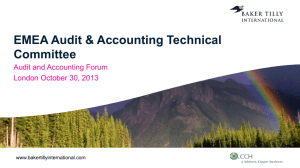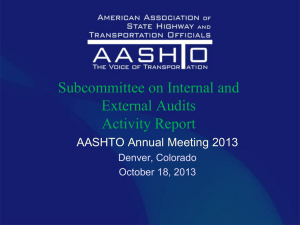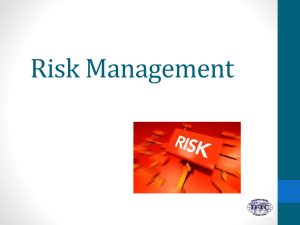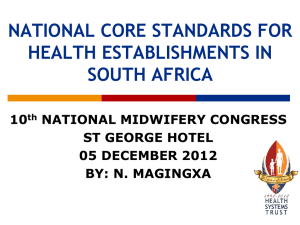Audit in Dental Practice (1)
advertisement
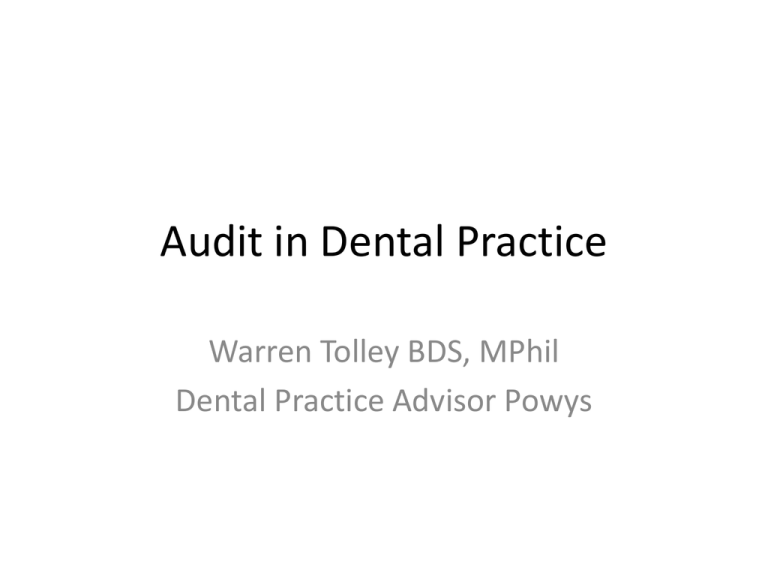
Audit in Dental Practice Warren Tolley BDS, MPhil Dental Practice Advisor Powys Why Bother with audit? • To help identify potential problems before it is too late! Clinical Audit • Encourages individual GDPs and PCDs to self examine different aspects of their practice • Identify areas of improvement • Ensure that quality is being maintained The Audit Cycle Set Standards Observe current practice Implement change Compare Against standards How do I enter the cycle? • • • • • • Decide on a topic that you wish to audit Decide on the standards to be achieved Collect data on current practice Compare this data to your standards Make changes where necessary Repeat at intervals to complete the cycle Key Points • • • • • S. M. A. R. T. Specific Measurable Achievable Realistic Time (Can be completed on time) Who to involve? • Dentists and PCDs within one dental practice • Collaborative- A joint audit between 2 or more dental practices • Avoid single audits • Collaborative audits are excellent for single handed practices especially in rural areas Remember • Introducing clinical governance to primary care, the government stated that it "must be seen as a systematic approach to quality assurance and improvement within a health organisation . . . Above all clinical governance is about changing organisational culture . . . away from a culture of blame to one of learning so that quality infuses all aspects of the organisation's work. The Good News • Funding is available for approved projects • A maximum of 15 hours for completed projects is funded at £65.07 per hour • A maximum of £130 travel allowance per project • The convenor of the project can additionally claim an extra 2.5 hours and secretarial support Possible Topics • • • • • Clinical Dentures Crown and bridge Deciduous restorations periodontology • • • • • Administrative Record keeping Health and safety Cross infection Timekeeping An Audit of Cross Infection Control and Practice 2007 Objectives • To establish that a series of cross infection control procedures were being carried out in line with the individual practice cross infection control policy • To audit both the dentist and nurse in cross infection • To review each individuals cross infection control policy and compare it with the BDA A12 document and implement any changes as required • To carry out a second audit • To make any further amendments following the second cycle Method • A data collection sheet was devised to look at a series of 12 cross infection control procedures that are commonly carried out in dental practice • The dentist and nurse filled in the data sheet • Prior to the audit each practice was asked to review their cross infection control policy in order to accurately fill in the form • 10 patients were observed for each category Cross Infection Control Procedures 1. 2. 3. 4. 5. 6. 7. 8. 9. Instrument decontamination and sterilisation Medical history form checked and updated Impressions disinfected and disinfectant used Clinical waste disposal and storage Protective clothing used Items intended for single use disposed of Water lines disinfected Safe sharp disposal Correct storage of sterile instruments 10. Aspirator cleaned and disinfected 11. Surfaces disinfected and disinfectant used 12. Zoning between clean and dirty areas practiced correctly Score Codes • 1= Practice best practice • 2= Minor Fault • 3= Serious breach of cross infection control policy Data Analysis • Data was collected from each practice • Kruskal-Wallis statistical test was used ( this test is appropriate for non-parametric data) First Round Audit Results • Statistical differences for categories 1 and 5 • No scores of 3 were produced • Categories 7,8,and 12 had increased scores of 2 Conclusions of audit 1 • Category 1: Nurses wearing latex gloves to clean instruments • Category 5: Dentists wearing prescription glasses • Category 7: Confusion on Disinfection of DWLs • Category 8: needle re-sheathing device • Category 12: Touching key board/door handles with dirty gloves Second round data collection • A12 document was read and discussed • Amendments were done to individual practice cross infection control policies • All practice staff were briefed on any changes • The audit was repeated Second round data • Statistical difference (P<0.05) in category 5 • The frequency of score 2 was reduced • No scores of 3 were awarded Frequency of score 2 in first round Frequency of score 2 in second round Conclusions • • • • • No serious breaches occurred Dentists are reluctant to wear protective glasses Useful in allowing nurses to observe dentists Both phases demonstrated a high standard Discussion phase of the audit is useful especially in a rural setting • The audit would be repeated on a regular basis and from part of new staff induction training • All staff would be encouraged to attend postgraduate courses Audit Project References • The BDA A12 document • Dental update • Public Health Wales Where do I get information • www.dentpostgradwales.ac.uk • www.cardiff.ac.uk/pgmde/dental mick@mickhorton.co.uk Finally............. • “It is not the strongest species that survive, nor the most intelligent that survives. It is the one that is most adaptable to change” • “To kill an error is as good a service as, and sometimes even better than the establishing of a new truth or fact” Charles Darwin




